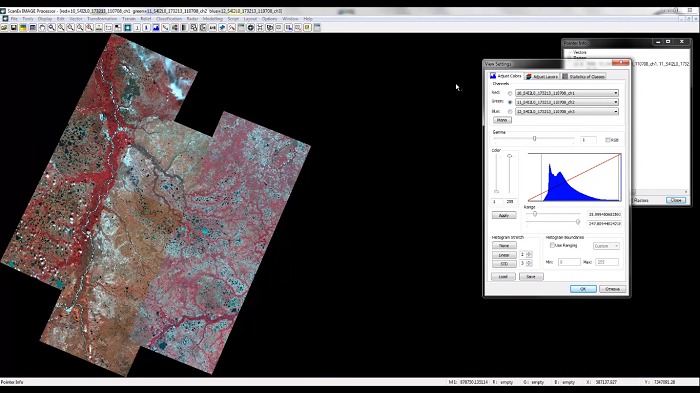ScanEx Image Processor

ScanEx Image Processor
ScanEx Image Processor is intended for geometric and radiometric correction of satellite and aerial remotely sensed data, additional processing of geometrically corrected data and creation of thematic products.
ScanEx Image Processor is intended for geometric and radiometric correction of satellite and aerial remotely sensed data, additional processing of geometrically corrected data and creation of thematic products.
- Image re-projection and resampling, including global geometric
- correction using automated image correlation, and interactive local geometry rectification;
- Creation of colour-balanced mosaics; image fusion; mathematical calculations;
- Change-detection;
- Vector editor;
- Calculation of thematic MODIS products;
- A flight-simulator on the basis of virtual 3D-landscapes created from images;
And a module for creation of georeferenced multi-image map layouts
Capabilities
ScanEx Image Processor is intended for geometric and radiometric correction of satellite and aerial remotely sensed data, additional processing of geometrically corrected data and creation of thematic products.
Creation of colour-balanced mosaics
ScanEx Image Processor helps to create colour-balanced mosaics from different types of images. A contrast smoothing is providing on-the-fly. It is possible both to “patch” a defect in an image (for example, a cloud-covered area) using another image and to mosaic the images to obtain a united raster coverage
Image Fusion
The software implements image fusion/resolution merge by combining multispectral images and panchromatic images of higher spatial resolution. Two methods are used: i) principal components analysis; ii) principal components analysis and wavelet decomposition of images. There are options to vary image fusion parameters and to preview the results in real time.
Mathematical calculations
The module provides the creation of various higher processing level and thematic products (e.g. calculation of the “blue” spectral band from other bands of a multispectral image for natural-colour transform; calculation of vegetation indices, such as NDVI, etc.). There is an option to calculate linear and non-parametric regressions. Tools are available for the users to create their own models.
Change detection
The application implements several widely used methods to detect the changes of spatial objects and one alternative method based on principal components analysis of images.
Vector editor
It is possible to calculate a number of thematic MODIS products in ScanEx Image Processor on the basis of standard algorithms developed within the framework of EOS programme. These are the cloud mask, the snow/ice cover mask, the Earth surface temperature mask, the vegetation indices, and the active fires mask.
Calculation of thematic MODIS products
It is possible to calculate a number of thematic MODIS products in ScanEx Image Processor on the basis of standard algorithms developed within the framework of EOS programme. These are the cloud mask, the snow/ice cover mask, the Earth surface temperature mask, the vegetation indices, and the active fires mask.
Output of processing results
The output module of ScanEx Image Processor allows preparing the image processing results for printing. Thematic maps and map layouts can be created featuring multiple image and map frames with georeferencing information.
Geometric correction
ScanEx Image Processor can implement geometric correction both with a predetermined geographical grid of latitude/longitude and with ground control points. A built-in correlator provides for semi-automatic image georeferencing (including images of different resolution and obtained from different sensors) with the accuracy of 0.5 pixel of the coarser image. Besides, ground control points can be added manually.
ScanEx Image Processor implements three alternative resampling methods on the basis of rectangular, triangular and cubical Hermite spline filters. These convolution filter methods allow the user to reduce the loss in image quality after resampling by means of a matched brightness interpolation across the whole image area.
Creation and visualization of 3-D landscapes
Procedures for modelling and visualization of 3-D landscapes are provided. Digital elevation models are used for the modelling along with remote sensing data; besides, it is possible to use vector data and 3-D models, to simulate cloud cover including animated clouds. ScanEx Image Processor is capable of real-time high-quality flight simulation over texturized 3-D models more than 30,000 х 30,000 pixels in size. It is possible to save the flight track and record it as a video clip. The control over the 3-D flight simulation may be exercised with the help of keyboard, mouse and joystick.
- Intel Pentium IV processor or compatible
- RAM 512 Mb
- 40 Gb of hard disk free space
- Monitor 1024×768 True Color
- ATI Radeon or Nvidia GeForce video card
- MS Windows XP/Vista